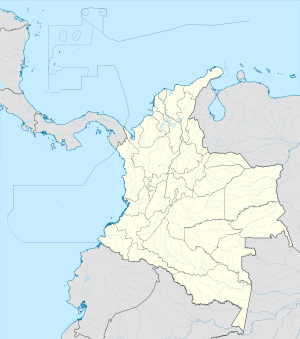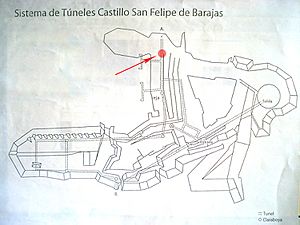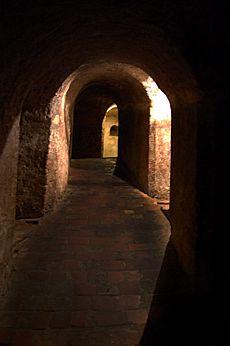Castle San Felipe de Barajas
Quick facts for kids Castillo San Felipe de Barajas |
|
|---|---|
| Cartagena, Colombia | |

Castillo San Felipe de Barajas
|
|
| Coordinates | 10°25′20″N 75°32′17″W / 10.42222°N 75.53806°W |
| Type | Bastion, Fortress |
| Site information | |
| Owner | Colombia |
| Controlled by | Colombia |
| Open to the public |
Yes |
| Site history | |
| Built | 1536–1767 |
| Built by | Antonio de Arévalo |
| In use | 1536–present |
| Materials | Stone |
| Battles/wars | Raid on Cartagena (1697) Battle of Cartagena de Indias (1741) |
| Garrison information | |
| Past commanders |
José de Herrera y Sotomayor (1739–41) |
The Castillo San Felipe de Barajas (which means San Felipe de Barajas Castle) is a very old and strong fortress in Cartagena, Colombia. It was built a long time ago, starting in 1536. This castle sits on a hill called San Lázaro. It was placed there to protect the city from enemies coming by land or sea. At first, it was called the Castillo de San Lázaro. The Spanish built it during the colonial era. The fortress was part of many important battles from the late 1600s to the early 1800s.
Contents
History of the Castle
The main construction of the fortress was finished by 1536. It was made even bigger between 1639 and 1657. The castle was built in a triangle shape on top of a hill. It had eight areas for cannons and enough space for 200 soldiers. The castle was named to honor Philip IV of Spain.
Battles at the Castle
In 1697, during a big war, the castle was attacked. A French privateer named Baron de Pointis took control of it. Later, in 1739, the castle was fixed up by José de Herrera y Sotomayor.
A famous British Admiral, Edward Vernon, attacked the fortress in 1741. This was during the Battle of Cartagena de Indias. But the Spanish admiral Blas de Lezo and his forces successfully defended the castle. Another part was added to the fortress in 1763 by Antonio de Arévalo.
Later, around 1815, a large Spanish army arrived in the area. Cartagena fell to them in December. By May 1816, the Spanish had control of the entire region.
Exploring the Castle
The fortress has many strong walls. They are wide at the bottom and get narrower towards the top. This design made it very hard for attackers to get in. The different parts of the castle protect each other. This meant it was almost impossible to capture one part without taking the whole defense system.
The castle is famous for its grand entrance. It also has a complex maze of tunnels inside. It is considered one of the strongest defense buildings built by the Spanish military. The castle stands 41 meters (about 135 feet) above sea level.
Key Features of the Castle
The main part is the triangular Castillo de San Felipe de Barajas. It is surrounded by other strong points called "batteries." These include Santa Barbara, San Carlos y Los Apostles, Del Hornabeque, de la Cruz, de la Redencion, and de San Lazaro. Together, these areas held 68 cannons. These cannons faced away from the city to protect it.
The castle also had special water systems. These helped collect rainwater and manage water flow. There is a main underground tunnel system. It runs along the edge of the castle near sea level. Some rooms in these tunnels could be exploded. This would stop enemies trying to attack from above.
Castle Today: Status and Care
The castle has not always been perfectly cared for. After it stopped being used for military purposes, plants grew over its walls. Soil also filled up some of the tunnels and trenches.
In 1984, UNESCO recognized the castle as a World Heritage Site. This means it is a very important place for everyone to protect. It was listed along with the historic center of Cartagena city.
Since 1990, the castle has been used for special events. The Colombian government hosts important meetings and summits there. For example, the Summit of the Non-Aligned Movement in 1995 was held there. The Summit of the Rio Group in 2000 also took place at the castle.
Today, the castle is open for visitors to explore. However, only some of its many tunnels can be seen.
See also
 In Spanish: Castillo San Felipe de Barajas para niños
In Spanish: Castillo San Felipe de Barajas para niños
- List of colonial buildings in Cartagena, Colombia





